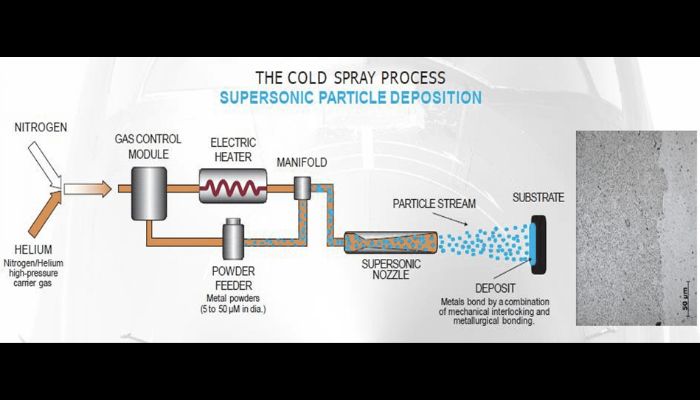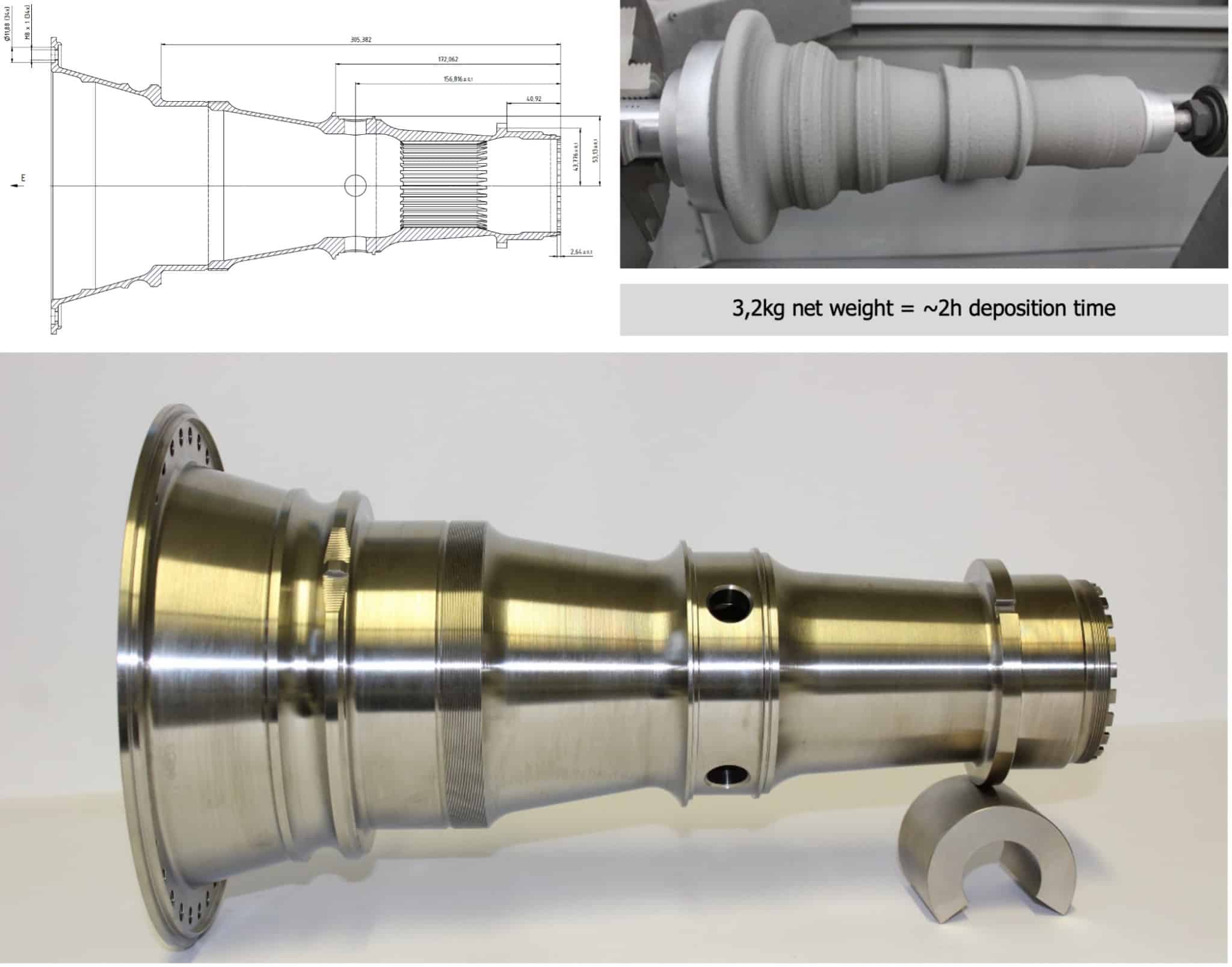
In additive manufacturing industry, there are a wide range of 3D printing technologies used for making metal parts, such as SLM, DMLS and LPBF. Cold spray additive danufacturing (CSAM) is a technique that offers another way to manufacture metal parts. In this process, CSAM does not melt the material. Instead, fine metal powders are launched at supersonic speeds onto a surface. Cold gas dynamic spraying is a method that creates or repairs components by layering materials. The lack of heat ensures that the material retains its original qualities, including strength, hardness, and durability.
Cold spray technology was not always utilized in industry. It started as a technique to restore broken components. But, over time, its potential became apparent. Engineers realized that it might be used not only for repairs, but also to make new parts with precision. The technology, which was previously limited to fastening metal components, turned into a fundamental additive manufacturing process for constructing complex parts.
The main advantage of Cold spray additive danufacturing is its efficiency. It requires less energy since it does not melt metals. This also means that the material is less strained, which reduces the likelihood of flaws. Furthermore, because the powders are administered immediately, waste is reduced. When compared to traditional technologies, which frequently produce surplus material, cold spray technology stands out.

How Cold Spray Works
The cold spray method is based on a simple yet powerful principle: speed. Metal powders including aluminum, titanium, and copper are fed into a cold spray powder feeder. These powders are then blasted through a nozzle by a high-pressure gas, often nitrogen or helium. This gas accelerates particles to supersonic speeds, which are far faster than the speed of sound. When these high-velocity particles strike the target surface, they connect without melting. This creates a solid layer.
The key variable in this process is impact. At such high speeds, particles distort and flatten when they impact with the substrate. They stick to it layer by layer, forming a dense, solid structure. Cold spray additive danufacturing differs from standard 3D printing technologies such as laser-based processes that rely on melting since it does not use heat.
Cold spray apparatus is very accurate. A spray pistol propels the powders, and a component manipulator ensures that the appropriate locations are addressed. Controlling the process necessitates skill and precision engineering, particularly when producing complex shapes.
Cold spray can be made from a wide variety of materials. Aluminum is popular for lightweight applications, whereas titanium provides excellent strength. Copper's high conductivity makes it perfect for use in electrical components. Cold spray's adaptability in handling various metals is one of the reasons it's gaining popularity in industries ranging from aerospace manufacturing technology to automotive and defense. The method is more than just making parts; it is also about conserving material qualities via supersonic particle acceleration.

Benefits of cold spray additive manufacturing
Cold spray additive danufacturing stands out because it maintains material integrity. Traditional additive processes, such as laser sintering, use high temperatures. This can result in unintended changes in material properties, such as bending, cracking, or altered microstructure. However, with cold spray technology, none of this occurs. There is no melting, thus the material remains strong and faithful to its original shape.
Cold spray 3D printing is great for temperature-sensitive materials like aluminum and titanium since it does not melt. You gain from high-speed metal powder deposition without compromising metal quality. The end product is sturdy, durable components that can be used at supersonic speeds while still performing to their full potential.
Another important advantage is speed. The cold spray additive danufacturing technology deposits material substantially faster than many other 3D printing processes. High deposition rates result in speedier production times. This is a significant benefit for industries that rely on time, such as aerospace and defense.
In addition to speed and resource preservation, cold spray generates little waste. Traditional manufacturing frequently produces a large amount of waste material, particularly in operations that entail cutting or milling. However, cold spray only utilizes what it needs. This makes it extremely efficient and in line with present aspirations for sustainable production methods utilizing cold spray.
The adaptability of cold spray treatments in aircraft is another advantage. It can be used to create new parts as well as fix existing ones. Cold spray has been proved in the harshest circumstances for engine components and structural sections. Cold spray coatings offer further protection against wear and corrosion in harsh environments. All of these advantages position cold spray as a critical component in advanced manufacturing.
Disadvantages of cold spray additive manufacturing
Despite its numerous advantages, CSAM faces significant problems. One key constraint is part geometry. The nature of the deposition process makes it difficult to generate complicated shapes and fine details. The method excels at manufacturing dense, robust pieces, but it suffers with complex geometries that other 3D printing technologies can handle more easily.
Another problem is accuracy. Cold Spray 3D Printing often has worse precision than laser-based technologies. To reach tight tolerances, cold spray parts may require further post-treatment, such as machining or grinding.
Cold spray technology has the potential to alter mechanical qualities as well. Although the technique preserves material qualities, residual stresses may form in the deposited layers. These pressures may degrade the finished product unless heat treatment or other post-processing techniques are used.
Commercial cold spray systems are still available in limited quantities. Smaller organizations find it difficult to invest in this technology due to its high costs and lack of general adoption. This reduces the possibility of cold spray applications in aerospace and other industries that could profit from the method.
Applications of cold spray additive manufacturing
Cold spray additive manufacturing has a wide range of applications across sectors. In aerospace, it is utilized to make high-performance, lightweight components as well as to repair metal components. Its ability to apply coatings that withstand wear and corrosion makes it excellent for use in harsh situations.
A famous case study is General Electric's use of cold spray in the development of jet engines. The technology has enabled engine repair and the development of tough coatings that can resist harsh circumstances. Beyond aerospace, cold spray technology is increasingly being used in the automobile and defense industries. It aids in the production of long-lasting parts and the enhancement of performance in the automotive industry. In defense, it is utilized for both repair and manufacturing parts that must withstand hostile environments.
These applications demonstrate cold spray's versatility and effectiveness in enhancing performance and extending the life of critical components across various industries.
Conclusion
Cold spray additive manufacturing (CSAM) is at the vanguard of emerging production technologies, with exciting developments on the way. Researchers are working to improve the cold spray process's deposition accuracy and expand the variety of materials that can be used. The development of hybrid techniques, which combine cold spray with other manufacturing processes, promises to capitalize on the benefits of several methods for more efficient production and higher part quality.
Furthermore, CSAM is growing as an important participant in sustainable manufacturing. Its potential for material recycling and waste reduction is consistent with global sustainability goals, providing a path to environmentally friendly industrial processes. Although obstacles such as part complexity and accuracy persist, continual advancements are planned to solve these issues, making CSAM an invaluable tool for engineers, manufacturers, and researchers. As technology advances, cold spray will have a greater impact on industries such as aerospace and automotive, cementing its place in creating the future of advanced manufacturing and sustainable practices.
FAQs
Q1: How does cold spray additive manufacturing work?
A1: Cold spray additive manufacturing involves accelerating metal powders to supersonic speeds with a high-pressure gas. These particles impact the substrate and connect without melting, resulting in a solid coating. This procedure avoids high temperatures, allowing the material to retain its original qualities.
Q2: What are the benefits of cold spray in manufacturing?
A2: The main advantages include the preservation of material properties due to the non-melting process, faster manufacturing times due to high deposition rates, less waste formation, and adaptability in handling diverse metals. It also adheres to sustainable manufacturing processes such as cold spray.
Q3: What materials can be used in cold spray additive manufacturing?
A3: Aluminum, titanium, and copper are among the most common materials. The technique is adaptable, enabling the use of a variety of metals depending on the purpose.
Q4: How does cold spray compare to laser-based additive manufacturing?
A4: The fundamental difference between cold spray and laser-based additive manufacturing is the heating technique. Cold spray does not melt the material, keeping its qualities, whereas laser treatments require melting, which can affect material properties and induce thermal tensions.
Q5: What industries benefit most from cold spray additive manufacturing?
A5: Industries like aerospace, automobile, and defense profit greatly. Cold spray is used to manufacture and repair high-performance parts, increase durability and wear resistance, and extend the life of components in severe situations.
